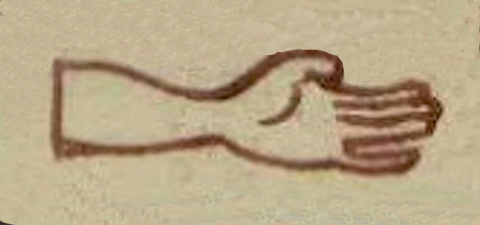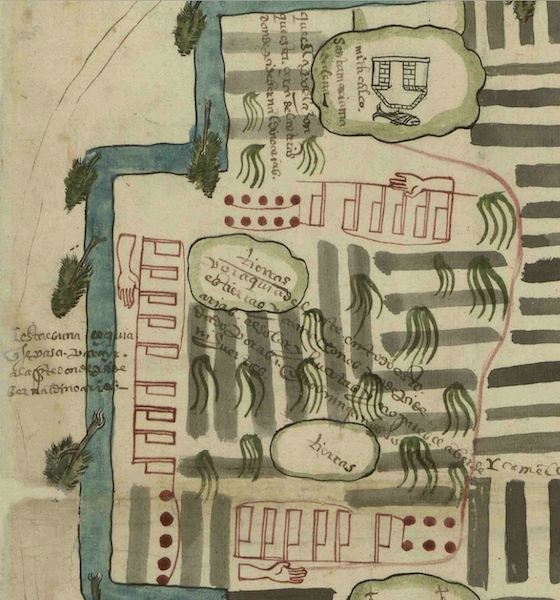matl (T2681:6:2r)
This is a simplex glyph of an arm and hand (matl), also known as a maitl), a unit of measure. It appears with two others on an Indigenous-style map submitted during a land tenure dispute occurring in the region of Santa María Magdalena Michcalco, a sujeto (dependency) of the pueblo of Cuitlahuaca, Chalco, in the Valley of Mexico.
Robert Haskett
According to Indigenous petitioners from Cuitlahuacan, led by the pueblo’s gobernador don Estéban de Caravajal, a man named Bartolomé Arias was attempting to gain a grant of a house lot and two adjoining parcels from the viceregal authorities that would compromise Indigenous land tenure and their ability to grow traditional crops such as maize and chiles there (an effort that ultimately failed on Arias’ part). The type of property in dispute is labeled (in Spanish) camellones by whomever provided the Spanish glosses on the map, but “translated” in related documents by Indigenous witnesses and a Spanish surveyor as either chinamitl or chinampas, the raised field constructed in shallow areas of the lakes such as those in the Chalco and Xochimilco region. Those requested by Arias are partially bordered by an irrigation ditch outlined in black and shaded in blue with what appear to be fir trees rising out of it at intervals. The total area involved measures 185 by 126 matl. This is represented on three sides of the affected territory by the simplex glyph lying horizontally and facing to the right under a series of right-facing tecpantli, banners, all outlined in red. Each of these banners represents twenty matl (nine banners on the longest side, six on each of the two other marked sides). These are in turned linked to a number of red one-unit dots (five on the 185 matl side and six on the 126 matl sides). Note how the first five banners in each set of measurements are grouped with a thin line, suggesting that the reading was meant to start with "one hundred," and the rest would be added to this--representing a shift in thinking toward a decimal system (introduced through Spanish colonization; see the historical contextualizing image). Spanish glosses on the map identify the area, but do not give a translation for what the matl stands for in the area as far as length is concerned. Unfortunately, accompanying Spanish-language witness testimony and other records do not provide it, either. However, measurements of this sort are often regarded as being the equivalent of varas (like yards) or brazas (fathoms).
Robert Haskett and Stephanie Wood
1579
measurements, hands, arms, brazas, varas
This phrase is found in translated witness testimony from Juan Damián, yndio macehual tepixqui (Indian commoner tribute collector) on folio 9r of Tierras vol. 2681, exp. 6. He is describing the property under dispute as measured with traditional Nahua methods.

ma(tl), a unit of measure, measured from hand to hand, the equivalent of about 6 feet, sometimes translated into Spanish as "braza," https://nahuatl.wired-humanities.org/content/matl
mai(tl), hand or arm; or, a measurement, https://nahuatl.wired-humanities.org/content/maitl
tecpan(tli), a banner representing 20, https://nahuatl.wired-humanities.org/content/tecpantli
Single-page codex, Archivo General de la Nación, México, Ramo de Tierras Vol. 2681, Exp. 6, Fol. 2r.
The Archivo General de la Nación (AGN), México, holds the original manuscript. This image is published here under a Creative Commons license, asking that you cite the AGN and this Visual Lexicon of Aztec Hieroglyphs.



